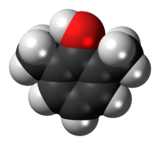2,6-Xylenol
 |
|
 |
|
| Names | |
|---|---|
|
Preferred IUPAC name
2,6-Dimethylphenol
|
|
| Other names
2-Hydroxy-m-xylene
|
|
| Identifiers | |
|
3D model (JSmol)
|
|
| ChemSpider | |
| ECHA InfoCard | 100.008.547 |
|
PubChem CID
|
|
| UNII | |
|
|
|
|
| Properties | |
| C8H10O | |
| Molar mass | 122.17 g·mol−1 |
| Melting point | 43 to 45 °C (109 to 113 °F; 316 to 318 K) |
| Boiling point | 203 °C (397 °F; 476 K) |
| Hazards | |
| Flash point | 86 °C (187 °F; 359 K) |
|
Except where otherwise noted, data are given for materials in their standard state (at 25 °C [77 °F], 100 kPa).
|
|
|
|
|
| Infobox references | |
2,6-Xylenol is a chemical compound which is one of the six isomers of xylenol. It is also commonly known as 2,6-dimethylphenol (DMP).
A known application of DMP is in the synthesis of Mexiletine.
2,6-Xylenol is a monomer for poly(p-phenylene oxide) engineering resins through carbon - oxygen oxidative coupling. Carbon-to-carbon dimerization is also possible. In one study 2,6-xylenol is oxidized with iodosobenzene diacetate with a fivefold excess of the phenol.
In the first step of the proposed reaction mechanism the acetyl groups in the iodine compound are replaced with the phenol. This complex dissociates into an aryl radical anion and a phenoxy residue. The two aryl radicals recombine forming a new carbon carbon covalent bond and subsequently lose two protons in a rearomatization step. The immediate reaction product is a diphenoquinone as result of a one-step 4-electron oxidation. It is nevertheless possible to synthesize the biphenol compound via a comproportionation of the quinone with xylenol already present. In this reaction sequence the hypervalent iodine reagent is eventually reduced to phenyliodine.
...
Wikipedia
